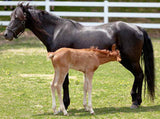Nutrition for the nursing mare
 With a foal on the ground to look after, a nursing mare's nutritional requirements are at an all time high. The tranquil picture of mother and baby together in the paddock can obscure the demands of motherhood: lactating mares have the highest nutrient requirements of any horse, with the exception of racehorses in heavy training. With the foal at term and delivered, Mum's job now is to meet the nutritional demands of her youngster for healthy growth and development, and that means milk, a lot of it. Thoroughbreds and other larger breeds can produce up to 18 litres of milk a day, and the total milk yield in the average Thoroughbred mare is 2,000-3,000 litres.
With a foal on the ground to look after, a nursing mare's nutritional requirements are at an all time high. The tranquil picture of mother and baby together in the paddock can obscure the demands of motherhood: lactating mares have the highest nutrient requirements of any horse, with the exception of racehorses in heavy training. With the foal at term and delivered, Mum's job now is to meet the nutritional demands of her youngster for healthy growth and development, and that means milk, a lot of it. Thoroughbreds and other larger breeds can produce up to 18 litres of milk a day, and the total milk yield in the average Thoroughbred mare is 2,000-3,000 litres.
Foals grow quickly and require a nutrient rich diet to support this. The nutrition of the mother makes a difference in the health, growth and development of the foal. If nutrition is not sufficient not only will the foal suffer, but nutrient reserves will be stripped from the mare to try and support milk production. It is Nature's goal for the foal to achieve 45% of his mature body weight by the time of weaning. To support this, milk production increases over the first four to eight weeks. After two months milk production gradually declines as the foal begins to obtain nutrients elsewhere. By 4 months the mare is providing roughly 50% of the foal's nutritional requirements and this has declined to about 30% by 6 months. However in wild pony populations lactation can continue for 10-11 months, with milk only drying up a few weeks before the next foal is due.
The first 12 hours after birth are a crucial time as this is when the mare produces colostrum. Colostrum contains a high concentration of immunoglobulin proteins via which the foal attains its immunity to infections. If the foal is to survive it is vital that it receives adequate colostrum, and this must occur within the first 24 hours of life. It is only within this short time window that the digestive system of the foal can absorb immunoglobulins as complete proteins. After 24 hours this ability is lost and colostrum will be broke down through normal digestion. After 12 hours colostrums production stops and the mare produces normal milk the composition of which is approximately 89% water, 2.7% protein, 6.1% lactose, 1.6% fat and 0.6% vitamins and minerals.
As stated above producing milk requires a lot of energy. If we take a 500kg horse, her energy requirements in the first month of lactation (according to the National Research Council of America's statistics) are 132 Megajoules a day. By comparison the maintenance level for an animal this size is 70 MJs and lactation demands are only eclipsed by horses in very heavy work, such as racehorses and elite three day eventers who would need 144 MJs a day on heavy training days. 4 months in and energy requirements are still very high at 123 MJs a day and by 6 months, even though milk production is lessening as the foal begins to obtain nutrients elsewhere, the mare still needs 113 MJs a day.
Unsurprisingly the lactating mare also has very high demands for protein and vitamins and minerals. If intake is not adequate, reserves in the mare's own body will be stripped to try and provide for the needs of the foal. This can have long term repercussions for the healthy development of the foal. For instance there is evidence of a link between copper deficiency and the joint developmental condition osteochondroisis dessicans which often first presents in yearlings.
The mare's crude protein requirements in the first month of lactation are almost 2.5 times maintenance levels (500kg horse), with requirements for the essential amino acid lysine running at 85g a day in the first month, slowly reducing to 67g/day by 6 months. Maintenance levels of lysine for a 500kg horse are 27g/day. On the vitamin and mineral front, her requirements in the first month of lactation are elevated across the board, but particularly so for calcium, phosphorous, magnesium, potassium and Vitamin A. The following table gives a snapshot of a mare's changing nutritional requirements.
The mare has carried the foal for 11 months and given birth, but her job is far from done. While we can share the joy of new life it is our duty as caretakers not to be distracted, and ensure that we continue to supply the mare with everything she needs for both the wellbeing of the new arrival and her own.

|
RELATED PRODUCTS |
|
 |
 |
| Lysine | Omega-3 |